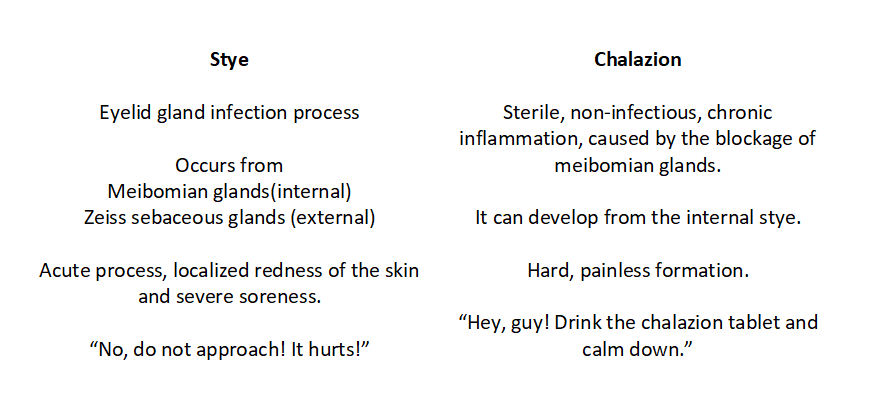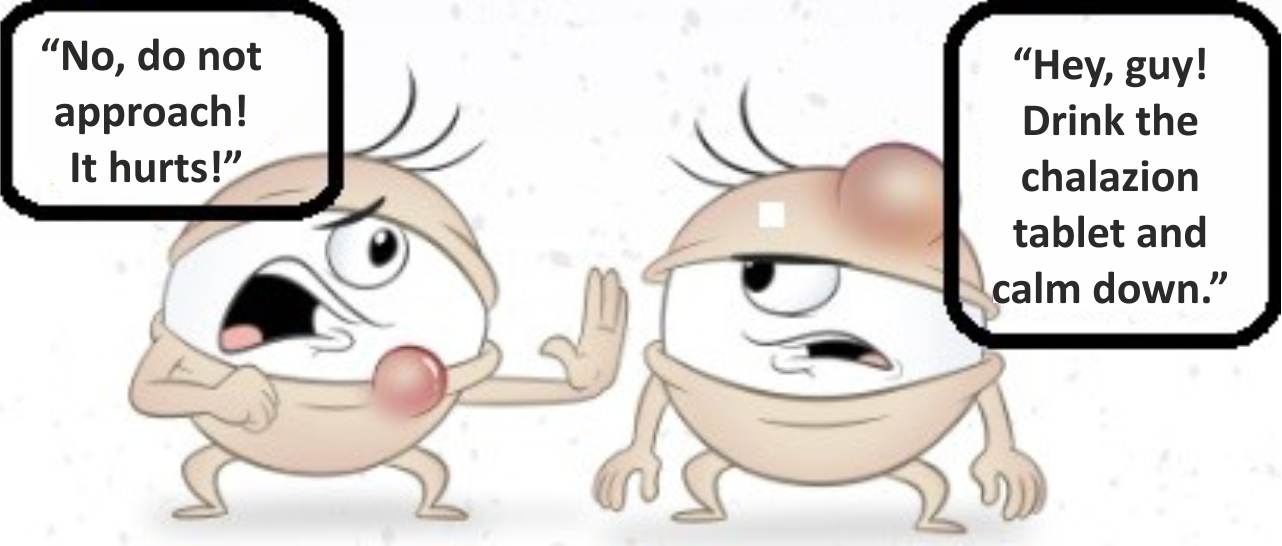What is chalazion and stye?
What is chalazion and stye?
In the daily ophthalmology practice, there is a frequent contact with patients who complain of pain in the eyelids or their edges, local swelling, redness. Nowadays, the so-called self-diagnosis has become very popular, and a large proportion of the above-mentioned patients when trying to find the cause of pain by using the websites on the Internet as the source of information often make a wrong diagnosis – stye or hordeolum. Unfortunately, sometimes similar wrong diagnoses are made also by family doctors when examining their patients.
Both of these eye diseases are caused by inflammation of the caudal meibomian glands or Zeiss sebaceous glands, that occurs either rapidly and acutely , or slowly and chronically. The myomic glands are located in the cartilaginous plate of upper eyelids and lower eyelids. There are 25-30 pc of them in each of the eyelids. These glands normally slowly produce the protective oily (lipid) layer that protects the eye from dryness and strengthens a tear film, protecting tears from premature evaporation. Their inflammation occurs when their outflow is blocked due to mechanical causes or infections.
What is stye or hordeolum?
It is a fast-acting, acute, purulent, uncovered by capsule (internal or white arrow) Meibomian glands and ocular surface inflammation (external or black arrow), which is mainly caused by staphylococcal infections.
In the vast majority of cases, the primary cause of the infection is the thickening of the gland secretion and the subsequent stage which creates a good environment for the development of the infectious bursitis.
The process begins with the emergence of a sensitive point on the edge of the eyelid, followed by a local swelling, on which within the period of 2-3 days a yellow “cap” appears. The eyelid oedema can cover the whole eyelid and be fairly pronounced, edema may also affect the mucous membranes of the eye or the conjunctiva. In the event of the appearance of an internal stye, the yellow “cap” will be visible only by expanding the eyelid.
Several styes may appear simultaneously, merge into one, and also relapse or restore over and over again.
Stye is more likely to occur when a person has a weakened immune system due to the use of medicines or adjacent diseases, as the body has not been able to fight against the microorganisms present in the body or entering from the outside and isolate the infectious bursitis.
How to treat stye?
In the early stage, the affected area may be exposed to dry heat (for example, an egg) for ~ 5-10 minutes several times a day, which helps the blood cells to reach the inflammatory focus and to “fight” against inflammatory agents and also to reduce the symptoms. In the case of stye, it is advisable to use local antibiotic drops or ointments. In the event that the drainage process does not occur, the eye doctor may recommend to make a small incision so that the matter can be released but in no case should the sty may be pulled out as this may contribute to the spread of the infection and inflammation process in the surrounding tissues and cause serious complications such as orbital phlegmon, meningitis, sepsis and other. Sometimes antibiotic tablets are prescribed
What is chalazion?
In the case of chalazion, the process of inflammation of the meibomian glands is slow and painless, and gradually increasing. Sometimes chalazion develops from stye, but more often it occurs independently. The factor that contributes to this process is the blockage of the gland output and the beginning of the inflammatory process, but the inflammation is mostly not an infection. By pulping it, you usually feel a solid, grain-like structure in the tissue of the eyelid. If chalazion recurs periodically, then there may be general health problems that secondarily cause the “wrong” gland secretion that causes the blockage of the glands. Unlike in the case of stye, the inflammation process of chalazion is enclosed by a capsule and therefore there is the possibility of effective surgical treatment, but the effect of locally applied antibiotics is not so good.
How to treat chalazion?
Part of the chalazion is spontaneously within the period from a week to a month. You must use warm, dry compresses and local antibiotic/corticosteroid drops or ointments during the acute period. However, in cases where chalazion does not absorb itself, surgical treatment is recommended. This is done by local anesthesia by forming a cut from the skin or conjunctival side and by removing it from the surrounding tissue. The formation, with as much as possible untouched capsule is evacuated. If the cut is made from the skin, then stitches are put in. If the cut is made from the inside of the eyelid, then stitches are not put in. On the day of surgery, an ointment is applied to the eye, which can be taken off the next day. When going home after surgery, the patient should not drive because of a closed eye. There can be a bruise on the eyelid, which can last up to 2 weeks. On the first day, it is recommended to use dry-cold applications in order to reduce the possibility of the post-operative oedema and bruising. After surgery, local antibiotic drops or ointment are prescribed. In some cases, surgical material is recommended to be checked histologically to ensure its goodness.
Summary








